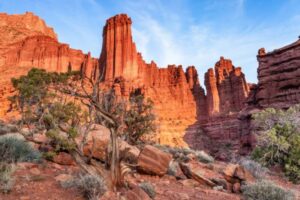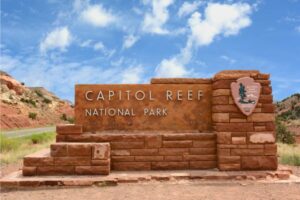Your Utah Camping Guide
From the otherworldly formations of Arches National Park to the hoodoos reaching for the sky in Bryce Canyon, Utah has camping adventures for every explorer. Seasoned backpackers seeking a challenge? Utah delivers. Families wanting a peaceful escape? Utah welcomes you with open arms.
Grab your tent, breathe in the fresh mountain air, and get ready to be awestruck by the wonders of the Beehive State.
Best Places To Camp In Utah
Moab
Set amidst dramatic red rock canyons and towering sandstone mesas, Moab is a haven for outdoor enthusiasts. Campgrounds abound, catering to various styles, from developed campgrounds with amenities like showers and laundry facilities to dispersed camping sites offering a more secluded experience. Explore the iconic Arches National Park and Canyonlands National Park, where you can witness breathtaking geological formations like the Delicate Arch and Mesa Arch.

Zion National Park
Renowned for its towering sandstone cliffs, cascading waterfalls, and emerald-green pools, Zion National Park is a camping paradise. Choose from campgrounds located within the park, offering stunning scenery and convenient access to hiking trails like the Canyon Overlook Trail and The Narrows. Backcountry camping permits are also available for those seeking a more immersive wilderness experience.

Capitol Reef National Park
Offering a unique blend of desert canyons, forested highlands, and colorful rock formations, Capitol Reef National Park provides a tranquil escape. Campgrounds are scattered throughout the park, offering various amenities and stunning views. Hike scenic trails like Hickman Bridge Trail and explore the Fruita Schoolhouse, a historical landmark.

Mirror Lake Highway (Hwy 150)
Winding through the majestic Uinta Mountains, Highway 150 offers a scenic drive and numerous camping opportunities. Popular campgrounds like Mirror Lake Campground and Rock Creek Campground provide stunning alpine settings with towering pines, crystal-clear lakes, and abundant wildlife. Hike through lush forests, go fishing in the pristine lakes, or simply enjoy the breathtaking mountain scenery.

Lake Powell
This vast reservoir, nestled within the Glen Canyon National Recreation Area, is a popular destination for water-based camping adventures. Established campgrounds with amenities line the shores, offering convenient access to boating, fishing, and swimming. Alternatively, explore the hidden coves and secluded beaches for a more intimate camping experience.

Things To Do In Utah
Zion National Park
Hikers can embark on thrilling adventures like the iconic Narrows hike, which takes them wading through the Virgin River through a slot canyon. The park also offers scenic drives, opportunities for rock climbing, and captivating wildlife watching.
Arches National Park
Located near Moab, Arches National Park is a wonderland of over 2,000 natural sandstone arches, each sculpted by millions of years of wind and erosion. Delicate Arch, Landscape Arch, and Double Arch are just a few of the park's most famous formations. Visitors can explore the park on scenic drives, hiking trails, and even participate in ranger-led programs to learn more about the park's geology and history.
Bryce Canyon National Park
Bryce Canyon National Park, also situated near the town of Springdale, is known for its unique hoodoos, which are tall, thin rock spires formed by erosion. The park offers breathtaking viewpoints like Inspiration Point and Sunset Point, which provide panoramic vistas of the amphitheater-shaped canyon. Hiking trails allow visitors to explore the diverse landscape up close, encountering hoodoos, ponderosa pines, and diverse plant life.
Monument Valley
This deeply spiritual place has been featured in numerous movies and TV shows, making it a popular destination for photographers and film buffs alike. Jeep tours offer visitors the chance to explore the valley's backcountry and learn about its cultural significance to the Navajo Nation.
Capitol Reef National Park
Capitol Reef National Park, located in south-central Utah, is a lesser-known gem offering a diverse landscape of canyons, cliffs, and orchards. The park's namesake, the Hickman Bridge, is a natural sandstone arch that dominates the landscape. Visitors can explore the scenic Fruita Valley, hike through slot canyons, and discover the Fremont River, which played a vital role in the lives of ancient indigenous cultures.
Dead Horse Point State Park
Soaring 2,000 feet above the Colorado River, Dead Horse Point State Park provides awe-inspiring vistas of Canyonlands National Park and the surrounding canyons. Hikers can traverse trails offering panoramic views, while photographers capture the dramatic landscapes, especially during sunrise and sunset. The park also offers opportunities for stargazing due to minimal light pollution.
Great Salt Lake
The Great Salt Lake, located northwest of Salt Lake City, is the largest saltwater lake in the Western Hemisphere. Visitors can experience the unique buoyancy of the lake, which has a salt content eight times higher than the ocean. The surrounding area offers opportunities for bird watching, kayaking, and exploring Antelope Island State Park, which is home to bison, wild horses, and diverse birdlife.
This is the Place Heritage State Park
Visitors can explore the park's living history farm, which showcases pioneer life through demonstrations and exhibits. The park also features the Salt Lake Temple, a significant landmark for The Church of Jesus Christ of Latter-day Saints, and offers guided tours to learn about its history and architecture.
Park City
During winter, skiers and snowboarders can enjoy world-class slopes, while summer offers opportunities for hiking, biking, and scenic gondola rides. The town also boasts a charming historic district with art galleries, restaurants, and shops, making it a vibrant hub for both outdoor enthusiasts and culture lovers.
Natural Bridges National Monument
Witness the marvels of erosion at Natural Bridges National Monument, situated near Blanding in southeastern Utah. Three massive sandstone bridges, carved by millennia of wind and water, dominate the landscape. Hike beneath the colossal arches, marveling at their size and the intricate details etched by nature.
Fish Lake
Surrounded by majestic mountains, the lake provides opportunities for fishing, boating, and swimming. Hike or bike along scenic trails, or simply relax on the shores and soak in the tranquility of the surroundings.
Monument Valley Navajo Tribal Park
Experience the cultural significance and breathtaking beauty of Monument Valley from a unique perspective at Monument Valley Navajo Tribal Park. Unlike the neighboring national park, this tribal park offers exclusive access to deeper regions by guided tours led by Navajo guides. Immerse yourself in the rich cultural heritage and gain insights into the Navajo way of life while exploring this iconic landscape.
Frequently Asked Questions
Become a Go Camping America Member!
OHI members enjoy an enhanced RV trip planning experience with GoCampingAmerica.com, featuring a powerful search engine to pinpoint the perfect campground or compare options along your route, exclusive member content like premium guides, in-depth destination information, and expert tips, and personalized camping resources like tailored recommendations and exclusive newsletters.
Join OHI today and unlock these benefits, along with networking opportunities to connect with fellow RV enthusiasts and industry professionals, access to business and marketing tools to help your RV park or campground thrive, and advocacy as part of a strong voice representing your interests at all levels. OHI membership is your key to a seamless and enjoyable RV travel experience. Visit ohi.org to learn more and join the community!

